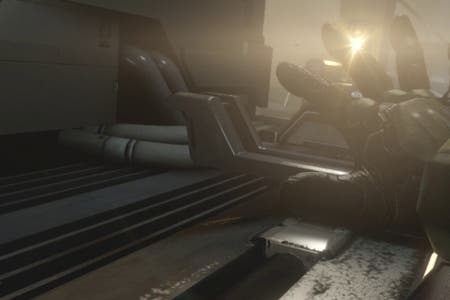What's the deal with quick-time events in Halo 4?
343 Industries' Frank O'Connor explains.
Halo chief Frank O'Connor has explained the quick-time events some Halo fans have expressed concern about in Halo 4.
Gameplay videos released by developer 343 Industries have shown how the player will be thrust into first-person quick-time event sequences during the game. One requires the player mash the X button to open a door. Another sees the Chief climb a devastated elevator shaft, with the player in control to some extent, moving left and right to avoid falling debris in a sequence some have compared to the Uncharted series. Once the Chief gets to the top of the shaft the player must press a button to grab a Covenant Elite and chuck him off the ledge.

At Eurogamer Expo O'Connor told Eurogamer these sequences are bunched together at the beginning of the game and are designed to train new players on Halo's systems in a dynamic and exciting way.
"You're only doing things you can actually do in the game," he said. "The first level is particularly dense with those things because it's teaching you about this world. So what you're doing in an elevator shaft is you're just climbing a ladder. You're doing things the Chief can do. It's not taking you out and forcing an animation. That was part of that philosophy.
"And some of it is just there for storytelling and drama. But it's also teaching you how to move through the world."
O'Connor went into more depth on the elevator shaft sequence, which occurs during the game's opening level, Forward unto Dawn.
"The whole purpose of that sequence isn't actually a ladder part," he said. "It's the melee combat that happens at the top where you kill the Elite. We're teaching you that you can physically defeat an opponent without a weapon and here's how you do it. We're just doing it in an especially dramatic fashion. It's luring you into the story as it teaches you these very basic principles.
"So for a player who knows how to play Halo, they're going to feel more like vignettes than gameplay because they're not used to seeing things from that perspective necessarily."

"The early stuff is dense because it's expositing a lot of information," O'Connor continued. "We know there will be a lot of players who are new to the Halo universe this time around, so we're just trying to teach those new players things in a way that isn't insulting or distracting to people who are perfectly capable of doing everything."
An example of how Halo 4 teaches the player its systems is found at the very beginning of the game, when AI Cortana wakes the Chief up from his four year slumber.
Rather than trigger an inverted camera sequence to determine how you like the controls to work, Cortana simply asks the player to look up and press X to exit the cryo chamber. "If you're a good player you'll just do what it told you when it said look up and press X to get out of the cryo chamber," O'Connor said. "Well if you're not an expert Halo player that will actually teach you something: you need to invert your controls because you looked down instead of up. And so on.
"We're trying to make it subtle. It's still important to teach people how to play the game. But we're trying to do it in a way that doesn't slow down the experience for people who are expert."
But how often will these vignettes occur throughout the game? Will we see more of them later on in the campaign?
"Most of those are in the beginning of the game where it's teaching you how to navigate and shoot and reload. There will be a few more that happen throughout the game but they tend to be for dramatic effect to focus on an action or a scenario but without switching to a cinematic," O'Connor replied. "So it's just letting you to continue to have some agency, because there's no real reason to switch to a cinematic, but we want to draw attention to a big idea. It's really just a narrative device."
Separate to these sequences are what O'Connor described as "conventional cinematic techniques". One of these, which takes place during the third level, sees the camera pull out to show Chief pull a level to turn off a pylon (you can see this in the Eurogamer Expo Halo 4 developer session video, below). In these cinematics the player is not in control of the Chief.
And O'Connor praised Halo 4 narrative director Armando Troisi, who used to work on Mass Effect, for "bringing a lot of really valuable player education as well as drama to the fold".









